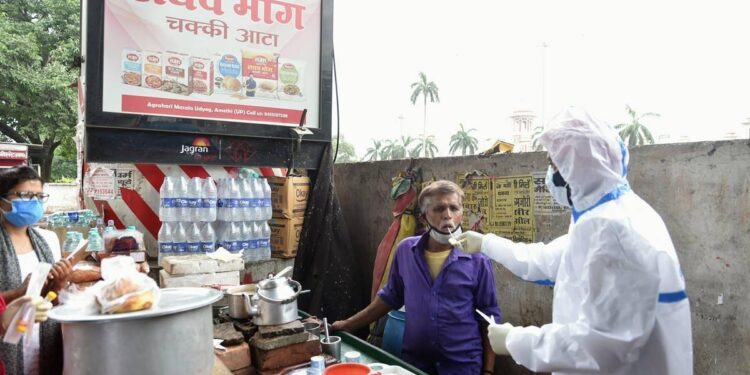 Rs 50.53 lakh was paid to street vendors in cash backs under PM SVANidhi scheme. (PTI Photo)
Rs 50.53 lakh was paid to street vendors in cash backs under PM SVANidhi scheme. (PTI Photo)Credit and Finance for MSMEs: Micro-credit scheme PM SVANidhi for street vendors, which disbursed nearly 21 lakh loan applications in 12 months, could have hit the “ambitious” 30 lakh annual target had Covid not disrupted disbursements in April and May this year, Ministry of Housing and Urban Affairs Joint Secretary Sanjay Kumar told Financial Express Online in an interaction on Thursday. Launched on June 1, 2020, the scheme offers a working capital loan of up to Rs 10,000 for a tenure of one year to Covid-hit street vendors including hawkers selling fruits, vegetables, tea, footwear, local snacks, books, etc., as part of the Atmanirbhar scheme. As of June 3, 2021, 20,65,204 loans involving Rs 2,045 crore were disbursed out of 24,25,208 sanctioned applications involving Rs 2,419 crore, as per the scheme’s available data from the Ministry of Housing and Urban Affairs.
“30 lakh was very ambitious target. However, we should have achieved that target or reached close to it in April and May but due to the second Covid wave, not even a single loan was disbursed. The situation is also likely to be the same in June. Moreover, while the scheme was launched on June 1, the processing of applications had started on July 2. So, three months went in vain,” Kumar said.
The collateral-free scheme is available to street vendors engaged in vending in urban areas on or before March 24, 2020, and who possess a Certificate of Vending or Identity Card issued by Urban Local Bodies (ULB). However, vendors who have been identified in the survey by local bodies to secure credit but have not been issued with the certificate or the card are also eligible. Such vendors are issued a Letter of Recommendation (LoR) by the respective ULB or town vending committee. Those who make timely or early repayment are also eligible for another cycle of the loan.
Moreover, vendors availing the scheme are also eligible for a 7 per cent interest subsidy credited into their bank accounts quarterly. Also, vendors opting for digital transactions for accepting payments are incentivized with Rs 50-100 in monthly cash backs. According to the scheme’s data, 20,65,204 street vendors had accepted payment digitally and Rs 8.72 crore in interest subsidy was paid to them. In terms of cash backs, Rs 50.53 lakh was paid to street vendors.
Subscribe to Financial Express SME newsletter now: Your weekly dose of news, views, and updates from the world of micro, small, and medium enterprises
“I’m not satisfied with Rs 50 lakh cash backs; a lot of work needs to be done on that to improve it. 20 lakh vendors are there and more than 5 lakh vendors are digitally active. While 5 lakh is not a bad achievement, we could do better. So, we need to change the strategy. It is one of our fastest-growing loan schemes. We have got another component in the scheme called SVANidhi Se Samriddhi started in January this year where we are trying to link beneficiaries with their families to aid government schemes like Jan Dhan Yojana, Jeevan Jyoti Bima Yojana, Suraksha Bima Yojana, etc.,” added Kumar.
However, the street vendors body National Association of Street Vendors of India claimed problems in the delivery mechanism of the scheme for its underachievement. “While the government’s outreach campaign was good but it didn’t think through the disbursement before launching it. The process of the rollout was very hazy. In the beginning, some municipal corporations were getting physical applications filled by vendors. Then there were some changes in the portal and so vendors were not able to file applications. The government relied heavily on municipal bodies rather than relying on town vending committees for accepting applications and sharing the letter of recommendation to banks,” Arbind Singh, National Coordinator, National Association of Street Vendors of India had told Financial Express Online.
Singh added that according to the Street Vendors Act 2014, the town vending committee is the representative body for street vendors and other stakeholders. But, “the government bypassed the town vending committees. Municipal bodies are the most incompetent of all government bodies and as a result, vendors faced challenges in getting credit from banks. 50 lakh is the targeted disbursements announced last year by the government for three years.” Among the top banks disbursing maximum applications under the scheme were SBI (6.15 lakh), Union Bank of India (2.37 lakh), Bank of Baroda (2.03 lakh), Bank of India (1.63 lakh), and Punjab National Bank (1.54 lakh). Fruits and vegetables (45 per cent), fast food and food items (21 per cent), cloth and handloom (13 per cent), beauty and fashion accessories (5 per cent), etc., were the top vendor categories.
Get live Stock Prices from BSE, NSE, US Market and latest NAV, portfolio of Mutual Funds, Check out latest IPO News, Best Performing IPOs, calculate your tax by Income Tax Calculator, know market’s Top Gainers, Top Losers & Best Equity Funds. Like us on Facebook and follow us on Twitter.
![]() Financial Express is now on Telegram. Click here to join our channel and stay updated with the latest Biz news and updates.
Financial Express is now on Telegram. Click here to join our channel and stay updated with the latest Biz news and updates.















